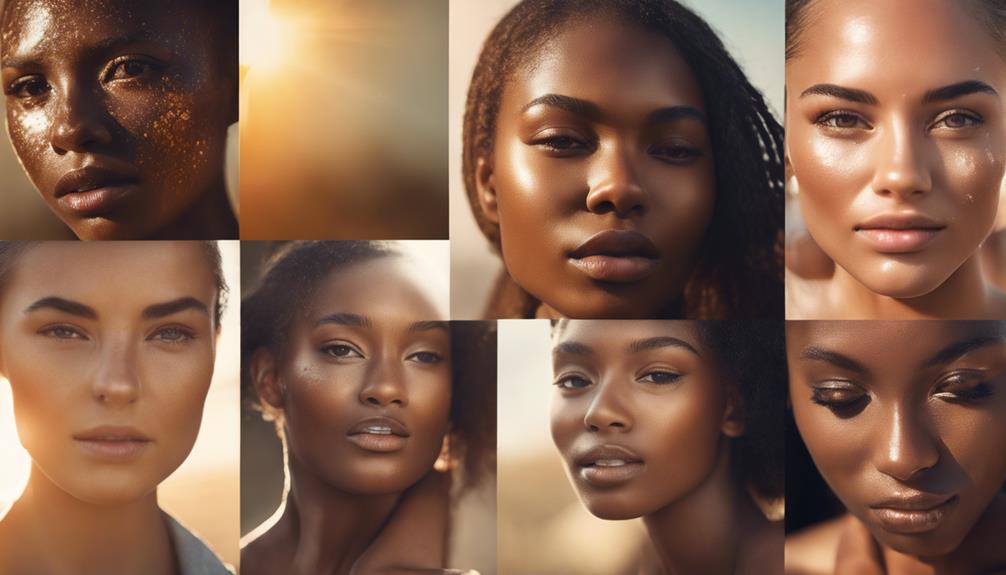To achieve the deepest tan for your skin type, it is important to choose the right tanning lotion. Aim for 3-5 sessions per week, starting with shorter times to see how your skin reacts, especially if you have fair skin. Make sure to hydrate your skin before and after tanning, and use lotions with L-Tyrosine and moisturizing ingredients for better results. Always remember to apply sunscreen to prevent burns and protect your skin. If you reach a tanning plateau, consider changing your routine or taking breaks. By following these expert tips, you will be one step closer to achieving the beautiful glow you desire.
Key Takeaways
- Start with 3-5 initial tanning sessions, gradually increasing time to build a deeper, richer color without burning.
- Use high-quality tanning lotions containing L-Tyrosine and moisturizers to enhance melanin production and maintain skin hydration.
- Monitor your skin type to determine appropriate UV exposure levels and avoid overexposure, ensuring safe tanning practices.
- Stay hydrated and nourish your skin both before and after tanning to improve elasticity and overall tanning results.
Tanning Fundamentals
Understanding the fundamentals of tanning is essential for achieving a deep, even tan while keeping your skin safe and healthy. When it comes to tanning, it’s important to start with a good base tan before spending extended periods in the sun or using indoor tanning beds. This will help to prevent sunburn and skin damage. Additionally, using a high-quality sunscreen with a good SPF is crucial for protecting your skin while tanning. Choosing the perfect tanning lotion shade can also help to achieve a more even and natural-looking tan.
You'll want to start with 3-5 sessions to see visible results, especially if you have fair skin.
Melanin, your skin's natural pigment, acts as a barrier against UV rays, so knowing how it works is vital.
A Skin Type Chart can help you determine your tanning needs, ensuring you avoid burns.
Consulting with tanning professionals can provide valuable insights tailored to your skin.
Remember, maintaining healthy skin is just as important as getting that desired tan.
Understanding Skin Types

Knowing your skin type plays a significant role in tailoring your tanning approach to achieve a safe and effective tan. Each skin type reacts differently to UV exposure.
If you have fair skin, you might be more prone to burns and need to start with shorter sessions. Medium skin types often tan well but still require caution. Darker skin types can usually handle longer sessions, but they should still monitor their skin's response.
Use a Skin Type Chart to identify your category and adjust your tanning strategy accordingly. Consulting with tanning professionals can also provide personalized guidance.
Optimal Session Frequency

To achieve a deep tan, you'll want to maintain an ideal session frequency that balances results with skin health. One way to maintain a deep tan while still protecting your skin is to use a tanning accelerator. These products can help enhance and accelerate the tanning process, leading to a darker and longer-lasting tan. Additionally, they can also provide moisturizing and nourishing benefits to the skin, helping to maintain its health and elasticity. By incorporating tanning accelerator benefits into your tanning routine, you can achieve a deep tan while still prioritizing the health of your skin.
Start with 3-5 sessions per week; this will help you build that rich color. After reaching your desired shade, aim for regular touch-ups of about 2 sessions weekly.
Remember to allow at least 48 hours between sessions to give your skin time to recover and prevent overexposure. Stick to shorter initial sessions to avoid burns, especially if you have fair skin.
Always consider your skin type and adjust accordingly. Consistency is key—keeping a regular schedule will guarantee that your tan develops evenly and lasts longer, while prioritizing your skin's well-being.
Choosing Tanning Lotions

Selecting the right tanning lotion is essential for enhancing your results and protecting your skin during the tanning process. With so many options available, consider these factors to maximize your tanning experience:
- Moisturizing Ingredients: Look for lotions that hydrate your skin, preventing dryness and promoting an even tan.
- L-Tyrosine: Choose products containing this amino acid to boost melanin production, helping you achieve a deeper tan faster.
Safe Tanning Techniques

Practicing safe tanning techniques is crucial for protecting your skin while achieving that desired deep tan. There are several safe tanning techniques that can help minimize the risk of skin damage and premature aging, such as using a broad-spectrum sunscreen and limiting sun exposure during peak hours. Additionally, using a tanning bronzer benefits individuals who want to enhance their tan without the harmful effects of UV rays. By incorporating these practices into your tanning routine, you can maintain healthy, radiant skin while still achieving your desired bronzed look.
Start by knowing your skin type; this helps you determine how much UV exposure you can handle without burning. Always wear protective eyewear to shield your eyes from harmful rays.
Establish a base tan with short sessions, gradually increasing exposure time while allowing at least 48 hours between visits. Hydrate your skin before and after tanning to maintain its elasticity and vibrancy.
Additionally, consider using tanning lotions with SPF and moisturizing ingredients to enhance protection. Regularly check your skin for any changes, and don't hesitate to take breaks if you notice any irritation.
Prioritizing safety guarantees you enjoy your tanning experience without compromising your skin health.
Overcoming Tanning Plateaus

Have you hit a tanning plateau and found it challenging to achieve that deeper color? Don't worry; it happens to many. Here are a few tips to break through that barrier:
Switch up your tanning routine: Try different beds or varying UV levels to stimulate melanin production.
Take a short break: A few days off can help reset your skin, allowing it to absorb UV rays more effectively.
Hydrate and nourish: Keeping your skin moisturized can enhance its appearance and support deeper tanning.
Maximizing Tanning Results

To maximize your tanning results, focus on consistent sessions combined with the right products tailored to your skin type. Aim for 3-4 sessions per week, allowing 48 hours between them to avoid overexposure.
Start with shorter sessions to gauge your skin's response, gradually increasing the duration as needed. Choose high-quality tanning lotions that contain moisturizers and L-tyrosine to enhance melanin production.
Apply your lotion evenly for a uniform tan. Stay hydrated and moisturize post-session to maintain your skin's vibrancy.
If you hit a tanning plateau, switch to different tanning beds with varied UV spectra. This change can stimulate melanin production and help you achieve that deeper, more radiant tan you desire.
Frequently Asked Questions
How Can I Maintain My Tan After Achieving the Desired Shade?
To maintain your tan after achieving the desired shade, hydrate your skin daily, use moisturizing lotions, and schedule regular touch-up sessions. Avoid excessive sun exposure, and consider using tan-enhancing products for longevity.
What Are the Signs of Overexposure to UV Rays?
"Too much of a good thing can be harmful." If you experience redness, peeling, blistering, or excessive sensitivity, you're likely overexposed to UV rays. Listen to your skin and take breaks to avoid damage.
Can I Tan if I Have Sensitive Skin?
Yes, you can tan with sensitive skin, but you should proceed cautiously. Start with short sessions, use gentle lotions, and prioritize skin protection. Always listen to your skin and adjust your routine as needed.
How Do I Choose the Best Tanning Bed for My Skin Type?
Imagine stepping into a tanning bed that perfectly suits your fair skin, avoiding burns while achieving that sun-kissed glow. Choose a bed with adjustable UV settings and consult professionals to guarantee ideal results tailored to your skin type.
What Should I Do if My Tan Fades Too Quickly?
If your tan fades too quickly, try moisturizing daily, using tan extenders, and reducing shower frequency. Also, consider adjusting your tanning routine to maintain color and guarantee you're using high-quality tanning products for better results.
What Expert Tips Can I Use to Enhance My Tan Using Tanning Bronzers?
Uncover the best tanning bronzer secrets unlocked to enhance your tan. Prep skin with exfoliation, apply a moisturizer, and choose a bronzer that complements your skin tone. Use a tanning mitt for even application and blend well. Remember to moisturize after tanning to maintain your golden glow.
Conclusion
As you commence your tanning journey, remember that 'patience is a virtue.' Achieving your deepest tan takes time and care, so don't rush the process.
By understanding your skin type, sticking to ideal session frequencies, and using the right products, you'll be well on your way to a radiant glow.
Prioritize skin health, and enjoy the journey to that sun-kissed look you desire.
Get ready to shine with confidence and flaunt your beautiful tan!







